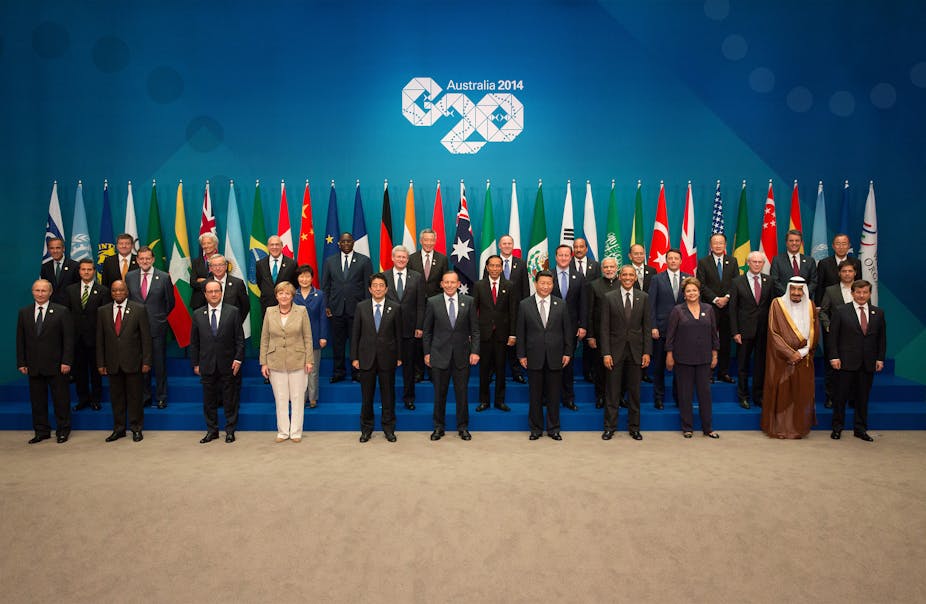The G20 summit in Brisbane has put the pressure on Australia to boost its action on climate change not just at home but also internationally through a new UN-backed fund.
The summit yielded major pledges to the Green Climate Fund by the US (US$3 billion) and Japan (US$1.5 billion). Combined with earlier pledges by France, Germany and others, the fund is now three-quarters of the way towards reaching its initial funding target of US$10 billion by the time of a pledging conference this Thursday.
Even Canada, which often sides with Australia on a go-slow response to climate change, plans to chip in.
Should Australia join other wealthy countries in making a substantial pledge to the Fund?
Australia backs away
After the Brisbane summit, Prime Minister Tony Abbott stated that “we are doing a very great deal and I suppose given what we are doing we don’t intend, at this time, to do more”.
But the claim that Australia is doing even a “great deal” on climate change just doesn’t hold water. Even if Australia had an ambitious domestic agenda, which the Coalition’s Direct Action strategy patently isn’t, reducing domestic pollution isn’t the end of the story.
As I’ve argued previously, it makes both strategic and moral sense for Australia to invest in low-cost opportunities to curb emissions in developing countries, while also helping vulnerable countries in our region to cope with cyclones, floods and other climate risks.
Both the Prime Minister and Foreign Minister Julie Bishop have cited aid to Pacific island countries as an example of Australia’s existing international climate action.
The Foreign Minister has also harked back to the A$600 million in “fast-start” climate finance that the previous government delivered over three years to mid-2013.
But since taking office, the Coalition has been reticent on further climate finance pledges. It has also poured cold water on the prospects of an Australian contribution to the Fund. Nor has the government spelt out a credible plan for meeting its share of a collective promise that wealthy countries have made under the Copenhagen climate Accord in 2009 to mobilise US$100 billion a year for developing countries by 2020.
Why the UN Green Climate Fund?
The Fund aims to help poorer countries achieve the shift to low-polluting development that is resilient to climate-related impacts. The Fund is unique in its capacity to catalyse the kind of large-scale investments required for this shift.
As well as channelling public resources, the Fund aims to leverage much larger private sector resources by reducing investment risks. In the longer term, this will help to lighten the burden on the budgets of wealthy countries.
How can we be sure that the Fund will be effective? The idea that multilateral agencies fritter away taxpayers’ money is a common bogeyman. But many larger multilateral development funds and programs perform considerably better (see page 16) than Australia (and indeed than most other bilateral government aid agencies) on efficiency and other measures of aid quality.
Through a painstaking design process, the Green Climate Fund has earned the confidence of both developed and developing countries. Under the previous government Australia played a central role in this process as co-chair of its board, and worked to ensure that the Fund will operate effectively with adequate financial and social safeguards.
How much should Australia contribute?
In a 2011 working paper, ANU colleagues Frank Jotzo, Peter Wood and I calculated Australia’s fair share of any collective climate change financing pledge to be 2-3%, based on its share of wealthy countries’ income and greenhouse gas emissions. This is in line with Australia’s recent commitment to the Global Environment Facility of 2.4% (see page 238) and other recent analysis published in Nature Climate Change.
Based on a US$10 billion target, a share of 2-3% would amount to US$200-300 million (A$230-340 million) or around A$60-85 million a year if spread over four years like the US pledge. This annual figure equates to less than 2% of Australia’s A$5 billion aid budget. And it represents a small share of over A$3 billion that Australia spends on public fossil fuel subsidies each year.
Even if the Fund’s initial target is met (which seems highly likely after the Brisbane summit), wealthy countries will need to ramp up their climate finance efforts further to achieve the US$100 billion-a-year target by 2020. But, as our research has shown, Australia could readily achieve a 2-3% share of the 2020 target by mobilising a range of public and private funding sources.
Assuming that Australia continues to maintain some level of climate change financing, it’s reasonable to expect that it will deliver its contribution through a range of channels. These channels could include Australia’s existing bilateral aid partnerships and smaller, special-purpose multilateral funds.
But if it refuses to back the Fund altogether, Australia would miss the chance to stimulate much larger investments from a modest public outlay.
Other wealthy countries of various political persuasions have concluded that it makes more sense to support the Fund than to snipe at it from the margins. Australia should not turn its back on a credible and important institution that it and many other countries have worked hard to build.

